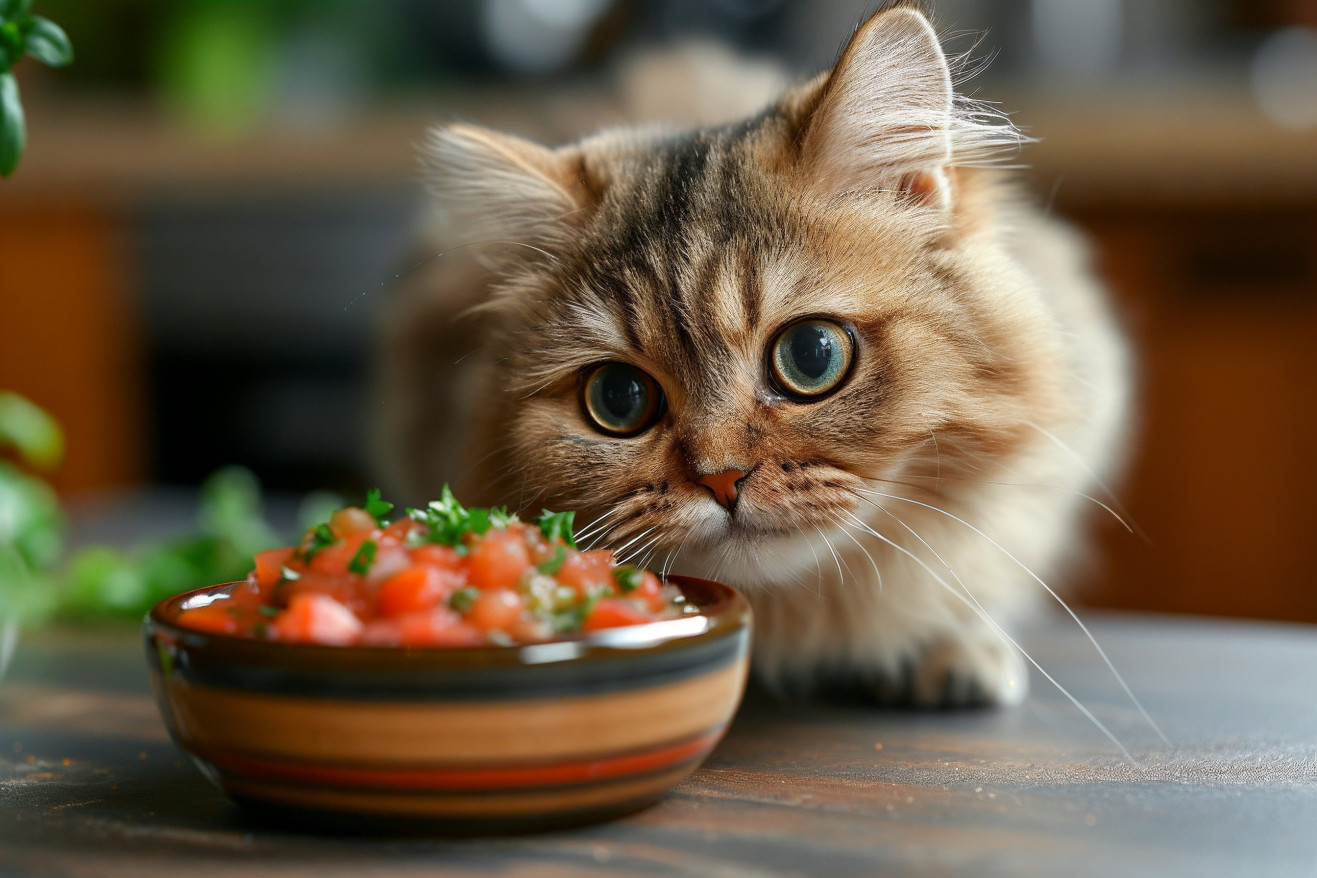Do Cats Like Spicy Food? A Look at the Science of Cat Taste Buds
2 February 2024

Humans love a little spice, but can cats even taste spicy food? With fewer taste buds than humans and no capsaicin receptors, the answer is no. Cats can’t taste spicy food, but that doesn’t mean it can’t cause them discomfort or other issues.
In this deep dive into the world of veterinary science and animal physiology, we’ll look at research on the anatomy of cat taste buds, the flavors cats can taste, and how cats’ bodies respond to capsaicin and other compounds. This information will shed light on the feline gustatory system and its limitations, and by the end of the article, you’ll understand exactly why cats experience the taste of food differently than humans.
Can cats taste spicy flavors?
Understanding the Feline Palate: A Look at Cat Taste Buds
According to Catster, cats have about 470 taste buds, a far cry from the 9,000 taste buds humans have. This difference helps to explain why cats’ sense of taste is so much less complex than ours.
While cats can taste bitter and sour, which are protective mechanisms that help animals avoid spoiled or toxic food, they can’t taste sweet because their taste buds don’t contain sweet receptors. This mutation is a result of the cat’s diet, which is primarily carnivorous and doesn’t require the sugars found in plants.
As Cats on Broadway Veterinary Hospital explains, cats’ preference for the high-protein meat they eat over the sugars found in plants is a result of their biology and confirms that they are obligate carnivores.
One thing to keep in mind is that the feline Jacobson’s organ is a key part of the cat’s taste-smell experience.
This allows cats to “taste-smell” odors in a way that may include the spiciness of spicy food.
Because cats are so sensitive to bitterness, which is a protective mechanism that helps animals avoid poisons, it’s unlikely that they would taste the heat of capsaicin as a flavor. In fact, they may not even be able to taste it at all.
Knowing this about cats’ taste and smell abilities helps to set the stage for understanding how substances like capsaicin interact with their unique senses.
Breaking Down the Spice: The Impact of Capsaicin on Feline Senses
Cats are unable to taste capsaicin, the active ingredient in chili peppers that causes the sensation of spiciness. This is because capsaicin activates pain receptors, specifically the TRPV1 ion channel receptor, which is sensitive to heat and acidity in humans. A 2023 study by Hansen et al. confirmed that cats do not have the TRPV1 ion channel receptor in their taste system, which is why they can’t taste spiciness like humans.
Research by the University of Chinese Academy of Sciences has shown that different animals have different reactions to capsaicin, and that some animals, like tree shrews, have genetic mutations that allow them to consume capsaicin without pain.
National Geographic reports on this research and suggests that cats’ status as obligate carnivores, as outlined in a study from the Proceedings of the National Academy of Sciences, may be the reason they haven’t evolved to have the same genetic mutations.
However, while cats don’t have capsaicin pain receptors, it’s still important to consider the impact of capsaicin exposure on cats. Even if cats can’t taste spiciness, ingesting capsaicin could still lead to irritation or other negative effects. As a result, it’s important to understand these physiological differences so that cat owners can ensure their pets’ safety and meet their behavioral needs.
The Taste Spectrum: Where Cats Fall in Mammalian Taste Perception
The taste spectrum in mammals is wide and varied, with different taste receptors and genetic and evolutionary factors playing a role in how taste perception has evolved. According to a study on PubMed, mammals have approximately 30 bitter taste receptor genes, which have mainly evolved to help animals avoid eating poisonous substances.
Meanwhile, a study in the journal Cell found that the sweet and bitter tastes are detected by the G-protein-coupled receptor family’s T1R1 and T1R2 proteins.
As a study in PMC explains, evolutionary factors like differences in diet and exposure to toxins have led to species-specific differences in the basic taste receptors. This genetic variation has resulted in differences in taste perception both between and within species. For example, humans can taste sweet and umami flavors, but cats, who lack the T1R2 receptor, can’t taste these flavors, which makes sense given their carnivorous diet.
Taste isn’t just about pleasure, it’s also an important survival mechanism that helps animals make decisions about what to eat and avoid. When you consider that cats can’t taste sweetness, it’s clear that they fall into a specific place in the mammalian taste spectrum that’s been shaped by their evolution and the way they eat.
This understanding of cats’ biology underscores the importance of feeding them in a way that’s tailored to their unique dietary requirements.
Feeding Your Feline: What to Avoid and What to Offer
If you’re a cat owner, it’s important to know what foods to avoid in order to keep your pet safe.
Make sure that spicy foods, which contain capsaicin, are at the top of your list of foods not to feed your cat.
Even small amounts of spices like oregano, cinnamon, and cilantro can cause stomach upset and discomfort in cats, according to AvoDerm.
In addition, spicy foods can often contain other ingredients that are toxic to cats, like onions and garlic.
To make sure that your cat is eating the best possible diet, opt for treats that are safer.
For example, steamed vegetables like carrots, asparagus, and squash, or a small amount of cooked eggs can be a great treat for your pet.
Catster notes that ingesting capsaicin can cause vomiting and a decrease in fluid intake. If your cat eats something spicy by accident, look for signs of distress. If your cat is showing symptoms and they don’t go away, or if your cat is acting differently, contact your vet immediately.
It’s important to remember that your cat’s diet should be based on their carnivorous nature, with an emphasis on animal proteins and low carbohydrates, according to The Spruce Pets. Knowing and respecting your cat’s dietary needs will help you keep your pet happy and healthy.
Cat Taste Buds: The Takeaway on Cat Spice Perception
In reviewing the intricate history of cat taste, it’s clear that cats’ taste perception is very different from humans’. With only about 470 taste buds, cats’ sense of taste is quite limited, especially since they can’t taste sweet and, by extension, spicy capsaicin. Their status as obligate carnivores has created a biological picture of taste that prioritizes meat over the complex flavors that humans enjoy.
Cats’ lack of capsaicin-sensitive pain receptors means that they can feel the burn from spicy foods, but they don’t experience the heat that humans do. This means that pet parents need to respect these dietary differences, respect cats’ biological needs, and not anthropomorphize their pets’ tastes.
In the end, let’s appreciate the specialness of cat taste perception. It’s a good example of the many ways that the animal kingdom experiences the world, and a reflection of the different evolutionary paths that species have taken.
When we decide what to give our cats from our own meals, we should make sure that we’re giving them something that will make them as happy and comfortable as our meals make us.


